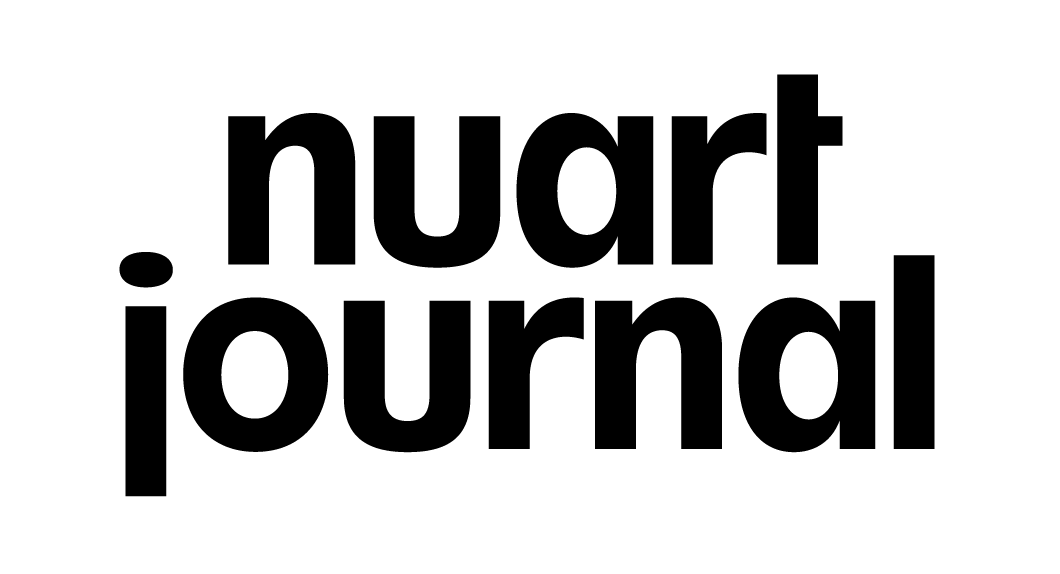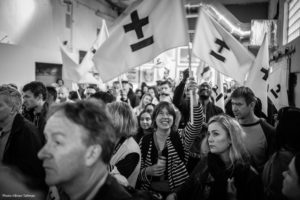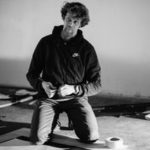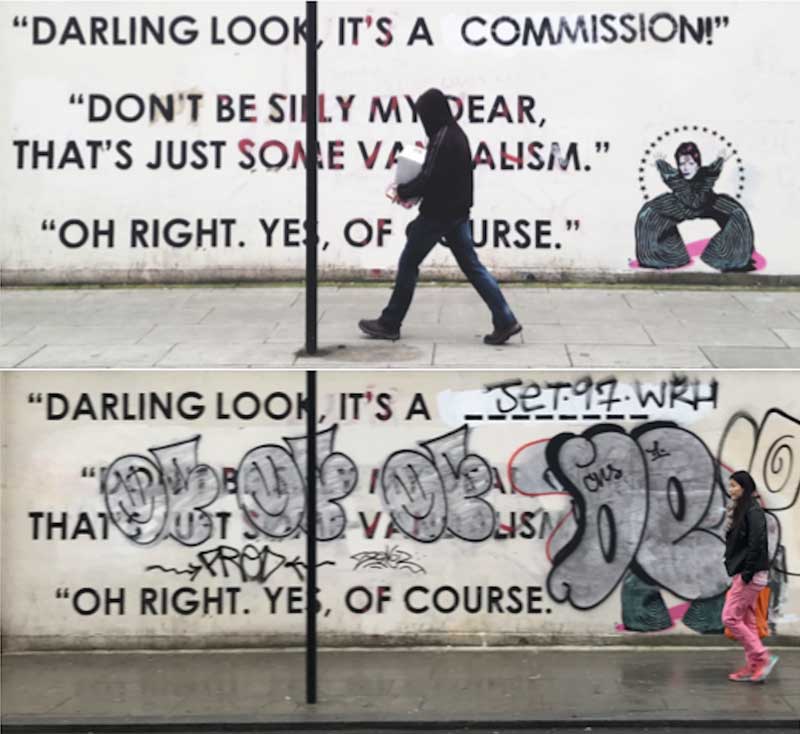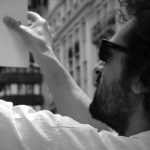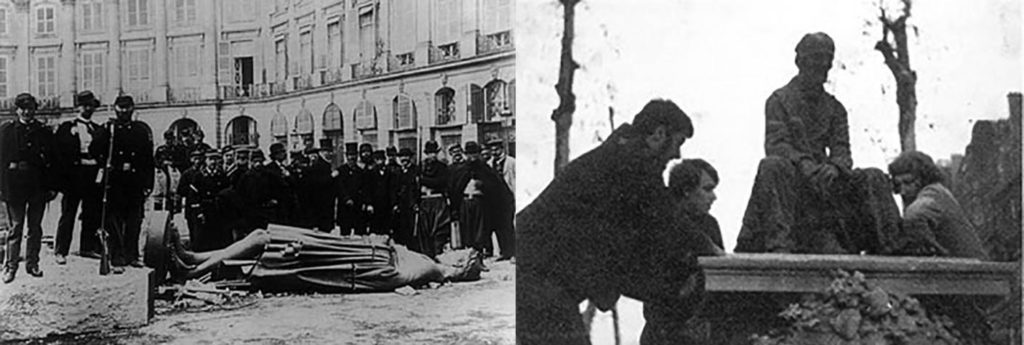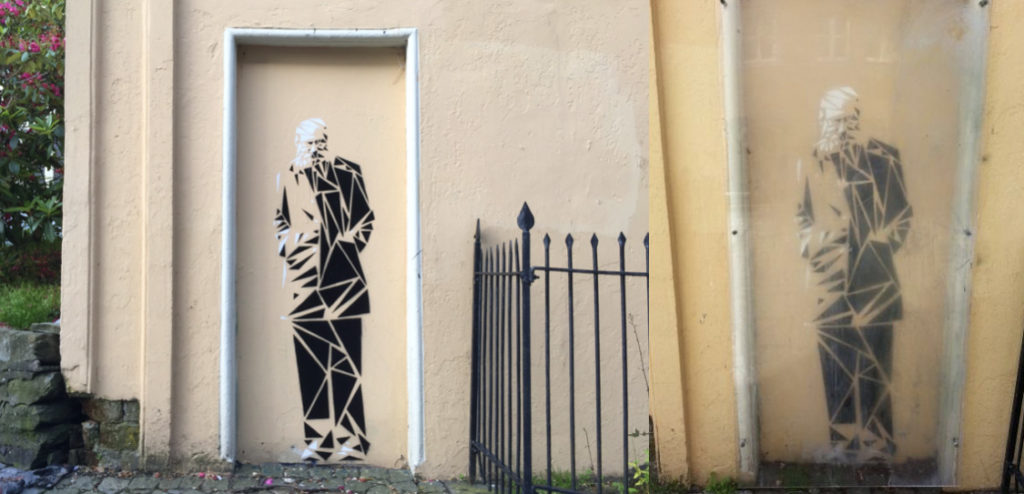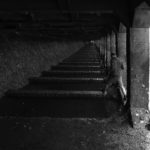We include this exhibition text in the journal as it covers ground rarely explored in either writings on contemporary art or street art/graffiti
A Major Minority: An Intercontinental Survey of Othercontemporary Urban Art
Exhibition Statement written by Poesia and Ekg.
Poesia (US)
Born in 1976, Poesia Transcend is a self-taught San Francisco Bay Area artist. During his early years as a graffiti writer at the turn of the nineties, he was recognized for his experimental Wildstyle pieces. In the middle of the decade, he became involved with the Transcend Collective. During this period, Poesia became one of the pioneering practitioners of what became known as Abstract Graffiti
Poesia is also the founder of the website Graffuturism.com that has led to the Graffuturist group or Graffuturism Movement. Graffuturism was founded in 2010.
EKG (US)
Somewhere between graffiti writer and street artist, EKG has made a name for himself with the quick stroke of his signature orange paint. His work resonates with the energy of the city. Dilapidated buildings, dirty subway stations, doorways, dumpsters — this artist leaves no surface untouched. A visual representation of the heartbeat — his work is simple yet easily recognizable and effective. Each time you encounter one of his tags, you get a sense that we are all somehow connected through the city. EKG reminds us all that it is our collective energy — the people — that brings life to NYC.
A Major Minority is an international exhibition consisting of urban artists from eighteen countries. Over a hundred artists will each be contributing three-to-five pieces, resulting in a massive survey of three- to five-hundred works of art. The concept and title of the show were developed by the graffiti artist Poesia, who is also the editor of Graffuturism.com and the cultural instigator at the center of the growing interest in abstract, progressive and hybrid Graffiti art forms. He elected to exhibit this large quantity and particular group of artists in order to display the wide spectrum of progressive hybrid aesthetics within the othercontemporary Urban Art community. This intensive and extensive sampling of stylistic specimens illustrates the broad continuum of approaches and aesthetics that fall under the purview of this art form, without focusing on any one sub-genre exclusively. His only stipulation was the size of the pieces, which he designated as the international standard “A4” (or 8.3″ x 11.7″) in order to symbolically emphasize the global scope of the survey, as well as the international cultural dominance of Urban Art at this time in art history.
By amassing this huge survey, Poesia presents the current Post-historical aesthetic moment of our Global Village as the natural evolution from the original form of Graffiti which manifested in the late Sixties. Both the above terms were created and defined fifty years ago in 1964 when they were developed independently by Arthur Danto and Marshall McLuhan in their works The End of Art and Understanding Media: The Extensions of Man respectively. Coincidentally, these two visionary texts articulated our new world during the same decade that Graffiti appeared within the urban environments of Philadelphia and New York City. At first Graffiti was simply known as Writing by the progenitors of the movement, but then the term Graffiti began to be used in the mass media, and it stuck in the consciousness of the populace and the next generation of writers as well. Since that time, this singular art form has gone through many more progressive mutations as it developed. Even within the last fifteen years, since the turn of the new millennium, Graffiti has found itself once again rejuvenated by the re-emergence of Street Art, which became a powerful cultural, aesthetic, and marketplace force this time around. As traditional Graffiti merges with Street Art and becomes what we have come to call Urban Art, A Major Minority illustrates this current maturity and intellectual self-awareness of itself in all it’s iterations and as the major global art form, expressing and engaging our post-historical, global village culture and psyche at the turn of the new millennium.
Despite this maturity, Urban Art has always remained on the edges of the art world and has never been bestowed true institutional recognition. At this point, Urban Art is a highly-developed movement with a rich fifty-year history, consisting of a wide-ranging community of practitioners, fans, merchants, and some institutional supporters. The use of the term Othercontemporary Art, coined by Stefano Antonelli, was settled upon during the discourse generated by the process of writing this exhibition statement, and encapsulates the concept that this is an art form which has always existed alongside but outside of what has become known as Contemporary Art by the critical, intellectual and institutional fine art communities. The term incorporates, but is not exclusive to, the ideals of The Other, Outsider Art and the recognition of an alternative version of art history of which Graffiti and its iterations are at the center of. The use of Othercontemporary is an attempt to create a specific and meaningful adjective for our proper nouns — Graffiti, Street Art and Urban Art — but it can also be used as an umbrella for those three terms, especially when used in opposition to the term Contemporary Art.
Because Urban Art has been misunderstood and ignored by institutions and their current version of art history, it was necessary to attempt to initiate and standardize a unique term that would augment and define this outsider art form. Over the past fifty years, Urban Art has not been canonized within the realm of Fine Art, but has actually been the singularly new, culturally relevant and globally dominant art form all along. At this point the term Contemporary Art has become so broad and meaningless that it ultimately only means art that is of the now, and yet it still remains one of the most common terms used when attempting to assign cultural relevance and historical pertinence to art. The term also actually falls into the same category as Post-modernism and Altermodernism, because it is merely another extension of the term Modernism, which had been used interchangeably with Contemporary up until the second half of the twentieth century, when Modernism began to sound antiquated and irrelevant. So, the decision to use the term Othercontemporary is an attempt to co-opt and subvert the term Contemporary and revitalize discussion around it. Whether the term itself is accurate or useful will be finalized only over time. Just like any other term that arises through cultural exchange, it will either die or live on, depending on its long-term viral cultural usage. This is only the beginning of that discourse, and over all, really, it still is mainly an adjective to the term Urban Art which will ultimately come to define this century, as Modernism is used to summarize the century before this.
So, Othercontemporary Art, a term which we define as having originated with Graffiti, extends its arms around Graffiti’s iterations and all are overseen by the umbrella term Urban Art, which contains in harmony and equality all these hybrid aesthetic forms which have originated outside the circumscription of traditional modernist theory and the established twentieth century art world, as well as civil society, the legal system, and the adult world. As mentioned, Graffiti manifested originally as Writing in the late Sixties. It was discovered and developed solely in the hands of adolescents through illegal marker and spray paint aesthetic interactions on the walls of the streets and the surfaces of subway cars in urban environments, with Philadelphia and New York City being at ground zero. Because of their extremely young age and unawareness of art history, Writing/Graffiti was truly an instinctual singular aesthetic cultural manifestation of our post-historical global village. New discoveries and innovations were transmitted by them directly and immediately on a daily basis from these public broadcast surfaces to each other and the general public as well. The marks were then analyzed and critiqued at “writer’s benches” around the city, and eventually in the form of photos appearing in periodicals, zines, books and electronic media as well. From these humble beginnings, the movement has continued to develop over the past fifty years due to the unique participatory and non-exclusionary nature of these means of transmission, therefore making it easily accessible to anyone and everyone in the urban environment. Because of these broadcast elements, the Graffiti signal is democratically assimilated, even though it is anarchistically disseminated. At first, these signals were transmitted only by illegal means, but as supporters were found and other avenues became available, the graffiti style was also broadcast on “legal walls,” therefore broadcasting Graffiti from the realms of Public Art, Community Art and Mural Art as well.
This interaction of the public with Urban Art and its populist acceptance by the majority has been portrayed as a negative aspect of the art form by the elitist gallery and institutional art world culture. Graffiti at its semiotic core though, because of the illegal nature of the medium it is broadcast through, is inherently an expression of populism and protest; Therefore it is important not to deny the mass attraction to it, but to recognize it’s communicative power, individualist nature, anti-status-quo subversion, and alternative community building aspects. As a matter of fact, we choose to wear it’s popularity as a badge of honor and a symbol of the successful infiltration, reception, and assimilation of our contentions with the critical, intellectual and academic elites, as well as all systems of societal, political and cultural control. Therefore, we embrace all styles and aesthetics that are visually engaging, but also that utilize this direct means of connection with the public within its own domain — the urban landscape — and transmit a message of transgression with the semiotic aura imbued by the illegal nature of the art form, whether it is expressed as direct action on the streets; as a stylistic homeopathy in the form of legal public art; as fashion, design or fine art commodities; and even in the constant visual and textual dialogue generated by it’s presence on the streets.
Each of the artists in the show has their own approach to and interpretation of this form of art, whether they emphasize style, concept, or medium at this stage in their development. But at it’s genesis, this movement is rooted in the act of unsanctioned mark making in the streets, which on some level has guided and influenced everything to follow. This may be the true basis of contention by critics and institutions, who feel unconscious trepidation about promoting an art form that developed from illegal actions that brutishly and anarchistically challenge polite civil society, cultural mores, the legal system, and ultimately the capitalist economic system of profits and private property, specifically when it pertains to who controls public visual display and communications. Whether intentional by the individual practitioner or not, Urban Art is a form of protest based in a public transgressive act, a visual civil disobedience that utilizes illegal aesthetic manifestations to broadcast disobedience from urban display surfaces. These illegal visual disturbances within the urban matrix may be one of the most important aesthetic and cultural questions of our time, and, as the separation between economic classes continues to widen, this collective cultural query will eventually need to be answered with something other than the current legal system’s definition of these aesthetic acts. Their utilization of the simplistic definition of these aesthetic protests as merely Vandalism does not address the deeper meaning of the collective cultural statement. The element of illegality at the genesis and core of this art form not only has driven the formation of style, choice of tools, and development of an alternative community, but also ultimately questions the existing societal and economic global systems and structures currently crumbling under the weight of the selfishness and myopia of the 1% ruling corporate class. This is not just an art form that speaks for the 99% aesthetic class, but ends up also challenging the 1% economic class in a similar way that Occupy Wallstreet does.
On the whole, this movement consists of a collective set of contradictions that embody today’s othercontemporary aesthetics, post-modern society and post-structural themes, as well as the economic, cultural, social and legal paradoxes in play. Poesia has chosen to focus this survey on artists he is familiar with from the context of Graffuturism, which as well as being the name of a website, has become recognized as a unique term he created to encapsulate the progressive hybrid aesthetic forms that have developed from the original discoveries of Graffiti. Even in the title itself, A Major Minority references the deconstructive influence of opposites and a network of disjunctions present in the survey, which is where much of the aesthetic power of previous but especially this particular phase of the movement comes from: activist/idealist, illegal/legal, graffiti/street art, letterform/non-calligraphic, popular culture/fine art, representational/non-representational, figurative/abstract, geometric/organic, minimal/expressionist, conceptual/aesthetic.
One could compare this level of development to parallels in the growth of any aesthetic form. At first an original aesthetic form is born as a crude undeveloped mark, equivalent to a new born baby, which then grows up and matures, learning to walk, talk and eventually explore all its possible facets, becoming intellectualized and formalized over time. An equivalent comparative example is Cubism. It’s birth had it’s genesis in the brute force, color palette and primitive shapes of Picasso’s Les Demoiselles d’Avignon. This moment in the manifestation of Cubism would be equivalent to the brute force of the illegal transgressions, crude tools, and primitive hand-drawn marks of the original tags of the Graffiti movement. In the second phase, the refinements of Picasso and Braque during the genesis and core explorations of deconstructed space and time of pure Cubism can be compared to the development of Wildstyle in the Graffiti movement. Wildstyle developed from the basic tag to a complex and unique calligraphic style of fast-flowing letterforms, eventually completely deconstructing the letterforms into abstractions of unreadable tags and piecing during the Golden Age of Subway Graffiti, all of which was guided by the impetus to work fast in order to avoid being arrested and the tactile nature of spray paint and ink markers.
Then in the third phase of aesthetic development, which in the case of Graffiti has lasted a few decades and included many sub-movement explorations, Cubism launched into a state of hybridization called Synthetic Cubism, when Picasso and Braque explored and combined other influences, such as contrasting color palettes, collage, impressionist painterly techniques, and other iterations within the Cubist style. This is the phase that Graffuturism falls into, which has also been called abstract, progressive and hybrid graffiti. It is an implosion of synthesis, an inclusion of all other art historical aesthetic forms, as well as any other kind of visual expression from pop culture, outsider art, illustration, advertising, and anything else that an artist may be attracted to. Once a form has developed to an extreme of complexity, artists search for their own voice within the movement by turning to their individual interests outside of the movement, including any other forms and tools, their indigenous cultural backgrounds and their particular historical roots. These three phases of aesthetic development can be applied to many movements from their crude genesis to their maturation as fully explored and extended aesthetic forms.
The above analysis of aesthetic development specifically situates the progressive forms of Graffuturism in the third stage of the formal growth of Graffiti. Urban Art on the other hand should not be seen as a linear extension from Graffiti, but as an umbrella term encapsulating the whole movement and all its sub-genres, much as the term Modernism covers many different movements that fall within the previous hundred years. Urban Art is a term that developed outside of the subculture and still rubs many practitioners the wrong way as yet another attempt at appropriation and gentrification, much like the term Graffiti still irritates many of the first generation of Writers and Street Art irritates many of those that considered themselves Graffiti Artists. The term Urban Art first appeared in the nineties within the advertising industry in the form of Urban Market in order to create a category of consumers consisting of urbanites who were into hip hop, graffiti, break dancing, and other connected cultural elements. Eventually Urban Art, an iteration of the advertising term, was adopted by the fine art auction houses for their Graffiti and Street Art auctions, which they applied even more broadly, to include skateboard-related art, Pop Surreal paintings, and many other forms.
Although the term Urban Art developed for economic purposes outside of the culture, it has come to be recognized by many within the movement as an acceptable term because these art forms could not have appeared in any other context than that of the urban environment. The realization of the broadcast function of urban public surfaces and the semiotic power derived from its illegal transmission are keys to the development of Urban Art. The urban environment offers of a matrix of concentrated societal elements that create a cultural frission when transgressed by the simple act of making an unsanctioned mark within it. Therefore artists can manifest their rebellious identities or revolutionary statements through public aesthetic actions that make powerful statements because of the semiotic aura accrued by their transmission through this media and the huge amount of people they can reach. Through these anarchistic actions artists can create autonomous omnipresent identities, entities equivalent to and in opposition to the massive corporate and legal authorities, as well as expressing more complex and subtle aesthetic statements and political philosophies. We accept all these entities created under the umbrella of Urban Art as statements and forms which are inherently valid and universally driven by our current cultural context. Writing was the originating signal, the original sin, an alternative deviant renegade code, the evidence and expression of our developing global village surveillance state that initiates when you appear as a biological blip on the radar, a tracking number for observance by the oppressive structures in place, and paradoxically expressed by Graffiti’s instinctual opposition to these systems, a semiotic guerilla action, taking to the streets and scrambling communications, creating new channels, spreading a hacker’s virus.
All of these terms from Graffiti to Urban Art, even if an attempt by outsiders to categorize and monetize a movement they really didn’t understand, still caught on and do ultimately define commonalities that fall outside of conventional markets, styles and theory because of their roots in the broadcast channel discovered by graffiti writers. Although there have recently been visionary curators such as Jeffrey Deitch and Cedar Lewisohn who come from a passionate and compassionate understanding of the movement, and who have successfully begun to champion and canonize the art form, there is still an overall lack of critical analysis, historical understanding, and theoretical thought on the matter. With the benefit of hindsight, driven by an outsider’s impetus and our insider’s passion, we hope to inspire and focus the spotlight and microscope on this situation. Utilizing and mutating current vocabulary and archeological dissection of intellectual objects, we hope to translate the why and how this movement was born, subsequently to become a globally dominant art form. Research being done by Poesia, Carlos Mare, Ekg, Martin Irvine, Martyn Reed, Anna Waclawec, Stefano Antonelli, Daniel Feral, and others who can utilize a scholar’s vocabulary and terminology to explain this movement will hopefully find insights and reveal connections between this othercontemporary art movement and the world that manifested it and is in opposition to it. Essays such as Irvine’s The Work On The Street, books such as Waclewec’s Graffiti and Street Art, and Feral’s historical info-graphic The Feral Diagram capture and express truths about this historical trajectory that will document and canonize the movement in a manner that Fine Art History can assimilate. These are deep documents on the subject that show a clarity and understanding beyond the thousands of coffee table books published on the subject and are able to clarify some of Urban Art’s key influences from and relationships to the fine art world, as well as its genesis as an aesthetic cultural force that can not be denied.
Meaningful scholarly endeavors such as the above are a unique reflection of today’s othercontemporary art world in which there is no longer a need for existing institutions and that their status-quo critical and theoretical structures no longer exist as the only means of canonization. This new historical thread called Urban Art can be traced to a new generation of artists, critical thinkers and theorists that speak to a younger larger audience than any biennial or museum can. These institutions are currently floundering in their attempts to recognize and exhibit any kind of art in the new millennium that attracts and engages broad young audiences. They continue to rely on old definitions, catering mainly to an academic and social elite that is still utilizing antiquated formal categories and standards to define what is relevant and important Art, and then force it on the public with the authority of a police state. As a result, they churn out massive retrospectives of Modern and Post-modern artists from the past hundred or more years which are mystifying and uninteresting to most. Because we are The Other, the major minority, an equivalent of Occupy Wallstreet’s 99% in opposition to the dominant 1% of the aesthetic class, we fall outside of the contemporary art market and the intellectual elite in all its forms. We speak to a new generation born into a new world with a resultant new model for aesthetics, art making, distribution, and consumption. This major minority is one of many to come in the future, always mutating, who will continue to gestate outside of academia and the current art world system, continuing to create progressive hybridized art forms that are truly relevant to the current and following generations.
A few closing words quoted from Martyn Reed: “From TED prizes and truly global art projects to record audience attendance at museums and institutions the world over, from front page headlines in mainstream media to Oscar nominated documentaries, Venice Biennale events to contemporary art institute shows, a thriving new market for entry level prints via online galleries has given the artist a new found freedom and in many cases a living wage. Not to mention “internet” fame. The ongoing success of this “bottom up” movement called “Street Art” is absolutely unprecedented in scale and scope. And perhaps more importantly, it’s inspired more people to pick up a can/brush/scalpel than all movements combined before it. It has brought art back into our communities and lives. Institutions? Pretty irrelevant really. We’ll build our own.”
Special thanks for discourse and feedback from: Stefano Antonelli, Martyn Reed, Martin Irvine, Anna Waclawec, Carlos Mare, RJ Vandalog, Brooklyn Street Art, Cedar Lewisohn, Caleb Neelon, and Daniel Feral.
